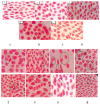Cytotoxicity and Genotoxicity Evaluation of Zanthoxylum rhoifolium Lam and In Silico Studies of Its Alkaloids
- PMID: 37513210
- PMCID: PMC10386057
- DOI: 10.3390/molecules28145336
Cytotoxicity and Genotoxicity Evaluation of Zanthoxylum rhoifolium Lam and In Silico Studies of Its Alkaloids
Abstract
The alkaloids isolated from Zanthoxylum rhoifolium have demonstrated great pharmacological potential; however, the toxic profiles of these extracts and fractions are still not well elucidated. This study evaluated the toxicity of the ethanol extract (EEZR) and neutral (FNZR) and alkaloid (FAZR) fractions. Chemical characterization was performed by chromatographic methods: thin-layer chromatography (TLC) and high-performance liquid chromatography coupled with diode array detection (HPLC-DAD). The cytotoxicity of the samples was evaluated in human hepatocellular carcinoma (HepG2) cells using the cell viability method (MTT) and mutagenicity by the Allium cepa assay (ACA). Alkaloids isolated from the species were selected for toxicity prediction using preADMET and PROTOX. The molecular docking of the topoisomerase II protein (TOPOII) was used to investigate the mechanism of cell damage. In the EEZR, FNZR, and FAZR, the presence of alkaloids was detected in TCL and HPLC-DAD analyses. These samples showed a 50% inhibitory concentration (IC50) greater than 400 μg/mL in HepG2 cells. In ACA, time- and concentration-dependent changes were observed, with a significant reduction in the mitotic index and an increase in chromosomal aberrations for all samples. Nuclear sprouts and a micronucleus of the positive control (PC) were observed at 10 µg/mL and in the FAZR at 30 µg/mL; a chromosomal bridge in FNZR was observed at 105 µg/mL, CP at a concentration of 40 µg/mL, and nuclear bud and mitotic abnormalities in the EEZR were observed at 170 µg/mL. The alkaloids with a benzophenanthridine were selected for the in silico study, as structural alterations demonstrated certain toxic effects. Molecular docking with topo II demonstrated that all alkaloids bind to the protein. In summary, the fractionation of Z. rhoifolium did not interfere with toxicity; it seems that alkaloids with a benzophenanthridine nucleus may be involved in this toxicity.
Keywords: Zanthoxylum rhoifolium; cytotoxicity; molecular docking; mutagenicity.
Conflict of interest statement
The authors declare no conflict of interest.
Figures






Similar articles
-
Gastroprotective activity of Zanthoxylum rhoifolium Lam. in animal models.J Ethnopharmacol. 2011 Sep 1;137(1):700-8. doi: 10.1016/j.jep.2011.06.026. Epub 2011 Jun 22. J Ethnopharmacol. 2011. PMID: 21723384
-
Structure-activity relationship of benzophenanthridine alkaloids from Zanthoxylum rhoifolium having antimicrobial activity.PLoS One. 2014 May 13;9(5):e97000. doi: 10.1371/journal.pone.0097000. eCollection 2014. PLoS One. 2014. PMID: 24824737 Free PMC article.
-
Comparative study on alkaloids and their anti-proliferative activities from three Zanthoxylum species.BMC Complement Altern Med. 2017 Sep 12;17(1):460. doi: 10.1186/s12906-017-1966-y. BMC Complement Altern Med. 2017. PMID: 28899423 Free PMC article.
-
Bio-guided search of active indole alkaloids from Tabernaemontana catharinensis: Antitumour activity, toxicity in silico and molecular modelling studies.Bioorg Chem. 2019 Apr;85:66-74. doi: 10.1016/j.bioorg.2018.12.016. Epub 2018 Dec 15. Bioorg Chem. 2019. PMID: 30599414 Review.
-
A Review on Classification and Biological Activities of Alkaloids from the Genus Zanthoxylum Species.Mini Rev Med Chem. 2021;21(3):336-361. doi: 10.2174/1389557520666200910091905. Mini Rev Med Chem. 2021. PMID: 32912124 Review.
Cited by
-
Healing and leishmanicidal activity of Zanthoxylum rhoifolium Lam.Front Chem. 2025 Apr 1;13:1504998. doi: 10.3389/fchem.2025.1504998. eCollection 2025. Front Chem. 2025. PMID: 40235717 Free PMC article.
References
-
- Lemée A.M. Flore de la Guyane Française. IV. Végétaux Utiles de la Guyane Francaise. Paul Lechévalier; Paris, France: 1956.
-
- Rodrigues E., Mendes F.R., Negri G. Plants indicated by Brazilian Indians for disturbances of the central nervous system: A bibliographical survey. Cent. Nerv. Syst. Agents Med. Chem. Former. Curr. Med. Chem. Cent. Nerv. Syst. Agents. 2006;6:211–244. doi: 10.2174/187152406778226725. - DOI
-
- Figueiró-Leandro A.C., Citadini-Zanette V. Árvores medicinais de um fragmento florestal urbano no município de Criciúma, Santa Catarina, Brasil. Rev. Bras. Plantas Med. 2008;10:56–67.
-
- Bieski I.G., Rios Santos F., de Oliveira R.M., Espinosa M.M., Macedo M., Albuquerque U.P., de Oliveira Martins D.T. Ethnopharmacology of medicinal plants of the pantanal region (Mato Grosso, Brazil) Evid. Based Complement. Altern. Med. 2012;2012:272749. doi: 10.1155/2012/272749. - DOI - PMC - PubMed
-
- Arruda M.S., Fernandes J.B., Vieira P.C., Da Silva M.F., Pirani J.R. Chemistry of Zanthoxylum rhoifolium: A new secofuroquinoline alkaloid. Biochem. Syst. Ecol. 1992;20:173–178. doi: 10.1016/0305-1978(92)90104-L. - DOI
MeSH terms
Substances
Grants and funding
LinkOut - more resources
Full Text Sources
Miscellaneous

